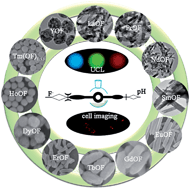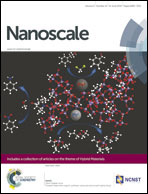Monodisperse lanthanide oxyfluorides LnOF (Ln = Y, La, Pr–Tm): morphology controlled synthesis, up-conversion luminescence and in vitro cell imaging†
Abstract
Lanthanide oxyfluorides LnOF (Ln = Y, La, Pr–Tm) nano/micro-materials with a variety of well-defined morphologies including nanorods, nanospindles, nanorod-bundles and nanospheres, have been successfully synthesized via a facile precipitation technique followed by a heating treatment. It is found that the pH values, fluoride sources and dosage of urea in the initial reaction systems play critical roles in the morphology determination of the LnOF products and the possible formation mechanism for these diverse architectures has been presented. XRD, FT-IR, TG-DTA, SEM, TEM, as well as up-conversion (UC) luminescence spectra are used to characterize the synthesized samples. Under 980 nm NIR laser excitation, red, green and blue UC luminescence are observed from Yb3+/Er3+, Yb3+/Ho3+ and Yb3+/Tm3+ co-doped YOF nanospheres. The MTT assay indicates that YOF nanospheres exhibit good biocompatibility. Especially, the emission spectrum of YOF: 0.20Yb3+, 0.04Er3+ nanospheres is dominated by a single red emission at 660 nm, which falls into the “optical window” of biological tissues. The application of YOF: 0.20Yb3+, 0.04Er3+ nanospheres in the cell imaging is also investigated, which shows a bright-red emission without background noise.


 Please wait while we load your content...
Please wait while we load your content...